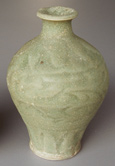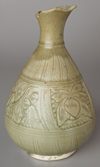
 Celadon
is a western word used originally to describe the green glaze of ceramics from
Longquan in China. An ash glaze (made of clay mixed with wood ash), it requires
2-5% iron, and must be fired in a reduction atmosphere.
Celadon
is a western word used originally to describe the green glaze of ceramics from
Longquan in China. An ash glaze (made of clay mixed with wood ash), it requires
2-5% iron, and must be fired in a reduction atmosphere.| Discovering Asia's ceramic development |

 Celadon
is a western word used originally to describe the green glaze of ceramics from
Longquan in China. An ash glaze (made of clay mixed with wood ash), it requires
2-5% iron, and must be fired in a reduction atmosphere.
Celadon
is a western word used originally to describe the green glaze of ceramics from
Longquan in China. An ash glaze (made of clay mixed with wood ash), it requires
2-5% iron, and must be fired in a reduction atmosphere.
A green glaze was in use in China by the 7th century, and during the Song dynasty (960-1280) this developed to a jade-like substance.
Celadon, like jade, was believed to have magical and protective powers. It was said that celadon would ring if danger was approaching, and would change colour to warn of poisoned food. No wonder it became so popular.
Celadon technique was arguably perfected by the 12th and 13th century, when it depended solely on balanced form. By the 14th century, motifs such as lotus flowers and stylised chrysanthemums were incised for decoration. From the early-14th century, blue-and-white porcelain was introduced, and gradually displaced the underglaze black tradition.
Celadon production in Thailand seems to have started in the later part of the
14th century - around the time of the 'Ming ban' of 1371 when emperor Hongwu
prohibited the Chinese from continued overseas trade. Many similarities support
our contention that this was no coincidence, and that Chinese migrants were
responsible.
Chinese celadon was found on the Turiang and Longquan shipwrecks.
Sisatchanalai celadon was recovered from the Nanyang, Longquan
and Royal Nanhai shipwrecks.
 |
| Exhibition index |